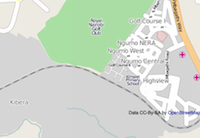NAIROBI, Jan 4 2010 (IPS) – In early November, a group of explorers set out to map a blank space in Africa’s map. Twelve youths armed with global positioning system (GPS) devices made the rounds of the Nairobi slum of Kibera.

While Kibera remains a blank spot, its limited resources, traffic patterns, and housing layouts remain invisible to outsiders and residents alike. Credit: OpenStreetMap
The teens are working with an organisation called OpenStreetMap to create a public map of their neighbourhood, seven kilometrs southwest of the city centre. It is the second-largest informal settlement in Africa, after South Africa’s Soweto township.
UN-HABITAT estimates its population at 500,000 to 700,000, with a density of more than 2,000 people per hectare. The settlement is divided into 10 villages, Lindi, Soweto (East and West), Makina, Kianda, Mashimoni, Gatuikira, Kisumu Ndogo, Laini Saba and Siranga.
Despite being home to about one million in a densely populated area, Kibera remains a blank spot in Kenya s map. The area lacks basic services like toilets and running water.
While Kibera remains a blank spot, its limited health and water resources, traffic patterns, and housing layouts remain largely invisible to the outside world, and to residents themselves, Mikel Maron of OpenStreetMap explains.
Though many organisations have collected data on Kibera, the information is not yet shared as a resource for all to use. Map Kibera will fill in this gap by producing free, open-sourced digital map data, using the techniques of OpenStreetMap, a user-edited map of the world. This information can easily be accessed and used by non-governmental organisations and private and public companies working in the area.
Related IPS Articles
The young mapmakers took part in a two-day workshop on geographic information systems before setting out to map important landmarks within the settlements. These images will then be scanned and placed in the geographic information system (GIS), and later uploaded into the internet and made available to everyone.
They are not qualified surveyors but ordinary youths who have been taught to use GPS technology. Partner organisations in the technology industry will help train and network with the Kibera community on the project.
Maron says the map will point out landmarks such as churches and mosques, schools, businesses, restaurants, the premises of organisations working in the area and government administrative offices. He says the project is not aimed at collecting demographic data, but rather consolidating information on public infrastructure.
Very little is known about what exactly goes on in the various villages. Indeed, people in Kibera may not be aware of all the facilities available, such as health centres and charitable organisations. The information we will consolidate will help those who wish to access Kibera know exactly where a particular place is, and what kind of service they provide.
That way it is easy for organisations wishing to work in Kibera to ascertain what extra services may be required, Maron says.
The project is spearheaded by the humanitarian OpenStreetMap team in collaboration with JumpStart International, and other partners including Jubal Harpster of WhereCampAfrica, the Social Development Network, Pamoja Trust, Hands on Kenya and Carolina for Kibera.
OpenStreetMap creates free editable maps of the whole world, which provide geographical data to anyone who wants them. The maps are uploaded on the internet and can be edited by anyone to provide additional information.
There has been a general lack of accountability on the projects going on in Kibera. With this kind of information available, it will be easy to know exactly which organisations are working in Kibera, including available services and facilities, Maron says. Besides mapping, the team will include details of landmarks.
Sheikh Ramadhan, a resident of Kibera, says the area has been turned into a cash cow for organisations claiming to work in the informal settlement, but many would be hard-pressed to show a tangible contribution.
Kibera is the only informal settlement in this country where we have more than 100 NGOs operating in this small area. But this has done very little to improve the lives of residents, and we still live in mud-corrugated structures with lack of basic facilities such as functional sewer systems and clean water, Ramadhan says.
Once the map is complete, the raw data will be available at no charge to upload into collaborative mapping platforms, for organisations that may need specific data on the area, including local authority and national government. The map will be updated as conditions change. Maron says it will operate in a way similar to the Wikipedia encyclopaedia, where anyone with additional information can add the data.
With this kind of knowledge it will be possible to speak from an informed point of view regarding planning of the area in terms of infrastructure. For instance we can flag how many health centres are available, where they are and what needs to be added, Maron explains.
Dr Siddharth Agarwal, executive director of the Delhi-based Urban Health Research Centre, says that rapid urbanisation and the growth of slum settlements poses a serious challenge to city planning. He says that in most of the world, including his native India, the majority of these areas remain. Spatial mapping, in his view, has not been used optimally for city planning to provide basic facilities such as health and sanitation.
One of the main obstacles to effective urban planning is a lack of up-to-date, comprehensive and sufficiently detailed information about urban areas. This lack of information is a major reason behind the failure of urban municipalities to include informal settlements in city-wide planning and urban development, Agarwal said.
In the absence of information about and understanding of slums, these settlements were typically considered to be chaotic masses rather than coherent urban areas, and thus are ignored or subject to planning aimed at them as slums to be eradicated rather than understood as an integral part of the city.